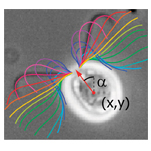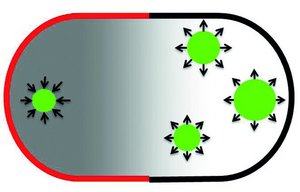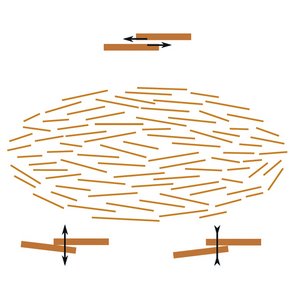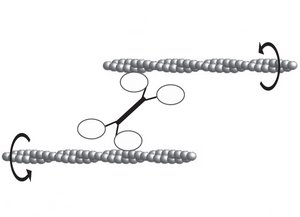Research Highlights 2013
Cell-body Rocking is a Dominant Mechanism for Flagellar Synchronization in a Swimming Alga

We study the mechanisms of flagellar synchronization in the green algae Chlamydomonas. Using a combination of theory and experiment, we show that cell body rocking generated by nonsynchronous beats effectively produces an interaction between the two flagella that drives their synchronization.
V. F. Geyer, F. Jülicher, J. Howard, and B. M. Friedrich
Proc. Natl. Acad. Sci. USA, 110, 18058 (2013)
[PDF (1,3 MB)]
Spatial Organization of the Cell Cytoplasm by Position-Dependent Phase Separation

The cell cytoplasm can undergo phase separation leading to the coexistence of drop-like objects with the remaining cytoplasm. Such phase separation generates droplets which concentrate certain components and provide specific chemical environments. We show how such phase separation can be used to segregate components in the cell cytoplams using a gradient of a regulator of phase separation. Such segregation plays an important role during asymmetric cell division. Cellular components can be distributed unequally to the two daughter cells.
C. F. Lee, C. P. Brangwynne, J. Gharakhani, A. A. Hyman and F. Jülicher
Phys. Rev. Lett. 111, 088101 (2013)
[PDF (1,6 MB)]
XMAP215 Activity Sets Spindle Length by Controlling the Total Mass of Spindle Microtubules

During cell division, a bipolar spindle assembles from a large numbers of dynamic microtubules. We show that length of meiotic spindles, which is much bigger than the average microtubule length is set by mass balance via localized microtubule nucleation and global disassembly. We show that perturbing microtubule growth rate using mutants of microtubule growth promotor. The spindle length is proportional to microtubule growth rate which can be understood by our theory.
S. B. Reber, J. Baumgart, P. O. Widlund, A. Pozniakovsky, J. Howard, A. A. Hyman and F. Jülicher
Nature Cell Biol. 15, 1116 (2013)
[PDF (4,6 MB)]
Active Chiral Processes in Thin Films

Active fluids exhibit unconventional behaviors such as the generation of spontaneous movements and flows, driven e.g. by the action of molecular motors in cells. The interactions between motors and filaments can amplify chiral asymmetries of helical filaments and lead to relative rotations and chiral flows. Active chiral processes are most striking near surfaces. We develop a thin film theory of chiral active processes which could be relevant for the emergence of chiral flows in the actin cytoskeleton in cells.
S. Fürthauer, M. Strempel, S. W. Grill and F. Jülicher
Phys. Rev. Lett. 110, 048103 (2013)
[PDF (340 kB)]